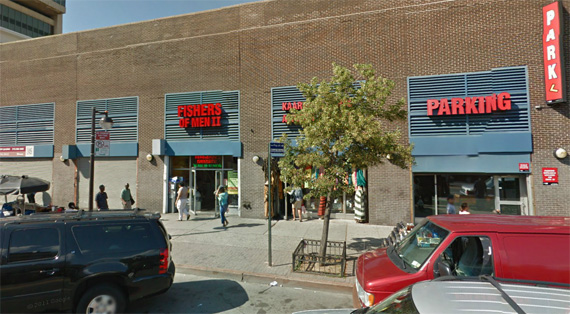
The New York City Economic Development Corporation's commitment to replacing any parking spaces the agency builds on top of is a one-way ratchet toward ever-increasing amounts of automobile infrastructure. For projects at Flushing Commons and the Lower East Side's SPURA site, slated to be built over surface parking lots, EDC has pushed for the new developments to include hundreds of parking spaces in addition to replacing the old parking.
In an RFP released Tuesday, EDC went a step further and asked for developers to try and replace every space included in a four-level garage located in the heart of Harlem at 125th Street. The request for so much parking seems to be based not on any transportation needs in the largely transit-dependent neighborhood, but rather on political negotiations with the local City Council member, Inez Dickens.
The low-slung garage, located between Adam Clayton Powell Boulevard and Lenox Avenue, currently houses 450 parking spaces, with a few small retail shops fronting Harlem's main commercial street. The site is owned by the city and the state, and by all accounts it's underutilized. Under current zoning, it could become a 363,000-square foot commercial building, assuming it takes advantage of bonuses for providing space for the arts.

In a section of the RFP noting the city's development goals, EDC asks that proposals seek to "maintain as many parking spaces as possible with the objective that as many of the spaces as possible be located below grade." Garage today, garage forever.
The impetus for that parking provision appears not to stem from EDC itself nor from any demonstrated demand for parking, but rather from Council Member Inez Dickens and negotiations over the controversial rezoning of 125th Street in 2008.
In a 2008 letter to Dickens, then-Deputy Mayor Robert Lieber mentioned the garage as one of the "Points of Agreement" from the rezoning negotiations, included in the RFP. In the letter, the administration committed to maintaining the current number of parking spaces and placing them underground. The preparation of an RFP for the site, Lieber promised, would be done in consultation with Dickens.
In fact, the language in EDC's new RFP leaves more wiggle room to build less parking than the 2008 letter suggests, requesting that developers preserve only as many spaces as possible, rather than all of them.
Given that flexibility, it is not clear that the future developer will actually rebuild all 450 spaces. The current garage has only one underground level, in addition to two above-grade and one on the roof. Putting all four floors of parking below ground would be extremely expensive.
Nor is demand for parking on the site particularly high. The garage "doesn't fill up regularly," said Kristen Sokich, the regional vice president of garage operator ProPark America, though he noted it had recently been full more often due to a large but temporary corporate account. Only 22.5 percent of area households own a car.
Dickens's office has not responded to Streetsblog inquiries about the garage redevelopment.





